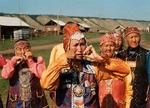 The Yakuts live in the Republic of Sakha (YakutiaYakutia), Khabarovsky krai. The Yakuts live in the Republic of Sakha (YakutiaYakutia), Khabarovsky krai.
The Yakuts are divided into two primary groups, based on geography and economics. Yakuts in the north are traditionally semi-nomadic hunters, fishermen and reindeer breeders, while southern Yakuts also engage in animal husbandry, raising horses and cattle.
Self-destination: Sakha
Language: Yakut (4 mutually intelligible dialect groups), belongs to Turkish group
Religion: Orthodox Christians, with elements of traditional animist beliefs
The Yakuts are most likely descended from a mixture of peoples from the area of Lake Baykal, Turkish tribes from the steppe and Altay mountains, and indigenous peoples of Siberia, particularly the Evens and Evenks.
When ethnic Russians first arrived in the region of Yakutiya in the 1620s, the Yakuts were living along the Lena and other rivers, functioning in a semi-nomadic, subsistence economy. They were organised in roughly 80 feudal-like patriarchal clans, but a broader sense of ethnic identity was already developing.
Russia annexed Yakutiya in the 1620s, and immediately imposed the fur tax. Soldiers and merchants poured into the area in order for the Russians to take control over Yakutiya and the numerous Yakuts. The Yakuts answered with several uprisings between 1634 and 1642, but the revolts were all crushed. The fighting, together with a variety of European diseased brought by the Russians, led to a decrease in the Yakut population. Many also tried to escape the Russians by migrating further east.
But during the 18th c., the Russians annexed more and more territories to the east - Kamchatka, the Chukchi peninsula, the Aleut islands, and Alaska. Yakutiya became a thoroughfare, and more and more Russians settled in the area. Other major events that changed the life in Yakutia, were the completion of the mailroute in 1773, construction of convict camps, discovery of gold in Yakutiya in 1846, construction of the Trans-Siberian Railway in the 1880s and -90s, and the development of commercial shipping on the Lena river. These developments contributed to the commercialisation of the region, and brought in "hordes" of Russian settlers.
Orthodox missionaries were also active in Yakutiya, and by the early 1800s, virtually all of the Yakuts were registered as Eastern Orthhodox Christians. But substantial elements of their folk religion survived.
After the Bolshevik Revolution in 1917, the Soviet government issued the "Declaration of the Rights of the Peoples of Russia", including a wide range of rights of self-determination, that largely remained on paper, as policies of "modernisation" later were put through. In 1924, a Committee of Assistance of Peoples of the North was established. They first proposed creating large reservations where the indigenous populations could continue their traditional life-styles. But instead, the Soviet government decided to integrate these peoples into the larger social, political and economic body of the country. In 1922, the Yakut ASSR was established. Inside the territory of the Yakut ASSR, several smaller national districts were established for the Evens, Evenks and Yukagirs, but, in most cases, Yakuts were placed in all politically important positions. The Yakuts were very numerous, and they were assimilating surrounding ethnic gr oups - even some ethnic Russians (Yakutyans are Russians who adopted Yakut customs, Kolymchans are Russians who adopted both customs and language from the Yakuts). oups - even some ethnic Russians (Yakutyans are Russians who adopted Yakut customs, Kolymchans are Russians who adopted both customs and language from the Yakuts).
Yakut nationalism met with tolerance until 1928, when Stalin launched his ruthless collectivisation campaign. Tens of thousands of Yakuts disappeared, and not until the late 1960s had the Yakut population recovered to pre-collectivisation levels.
With Gorbachov's Glasnost and Perestroyka policies, Yakut nationalism again found expression. Mounting conflicts between Moscow and the peoples of the far north, culminated in the creation of the Association of Peoples of the North (APN) in March 1990.
On August 15th, 1991, the Supreme Soviet of Yakutiya declared the sovereignty of the Yakut Republic. This was not popular with Moscow, and demography was on the Russian side in the dispute. The Russians outnumber the Yakuts by 2 to 1 in Yakutiya, and their loyalty was with Moscow. So, independent Yakutia did not become reality.
|













 State
State  Nations of Russia
Nations of Russia